#antique sewing machines
Note
Hey Pink,
so I went to a flea market today and scored a old singer machine for 10€! Now I'd like to know when it was made and probably where but I'm completely lost, maybe you could shed a little light on it?
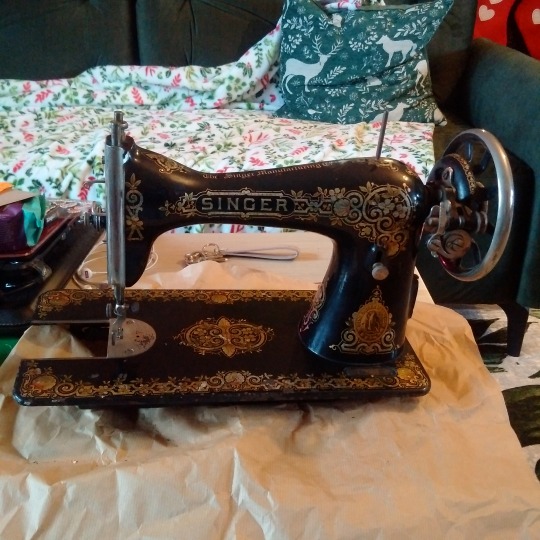

I cleaned the serial number plate as best I could. I suppose it reads: G67875 (2 or Z, I cannot tell)
Thank you so much!
It's a Model 15!
Here's some more information on the Model 15. Note that they're calling theirs the "15K", but the K just indicates that it was made in Scotland. Yours is likely a 15 and not a 15k, unless it says it was made in Great Brittan in the text along the top.
If you're ever unsure about the date on a Singer machine, I recommend this taxonomic key, and the Ismacs serial number database.
We can tell from the bobbin threading path on the front that this is a very early Model 15. According to the serial number, it's likely one of a lot of 50,000 made in January of 1910.
I believe the decal style on that is called Tiffany or Gingerbread. The first thing that I noticed about that is the absolutely exceptional state of those decals. Usually, machines of this age have a lot of the decal work worn off. If you want to clean them, be careful about damaging them.
The best advice I've found for cleaning and restoring old machines is from Doug at treadleon.net. Here's an excerpt from one of his articles:
Now let's talk about appearance. Some folks like to see an old machine shine like new. If the basic decoration, paint and decals, is good enough, that can be done. Most machines we find in sales aren't quite that good, or may actually be very bad. I like to let old machines show their age and usefulness. To clean a machine's surface, I use first a gentle mix of diluted dish soap and water, rubbing small areas at a time with a soft cloth. Often there is old dried oil or shellac on the surface. The earlier cleaning with kerosene may have loosened a lot of that up and it will rub off, too. Often it can be scraped off with a fingernail. Don't use hard scrapers, you'll scratch the enamel. Once I have the plain dirt off, I wipe with sewing machine oil several times over a period of days, then wipe off all the oil and wax. I use Turtle Wax. Other folks have had good luck with ArmorAll.
There are folks who favor various cleaning compounds, such as Simple Green, 409, Windex, etc. Great care must be exercised here. Many of the chemicals in these compounds, especially ammonia, will destroy the gold in the decals, leaving you with silver decals, or no decals. Since the decal content and manufacturing varied over the years and between manufacturers, the fact that a product did a great job on one machine does not mean it will not damage another. Always start by cleaning a small area in back of the pillar to see what is going to happen.
I've also found that liquid wrench spray penetrating oil can get through some really nasty dirt on the machines and it pretty decal-safe. It's become my main "clean now or else" tool for when dish soap is not doing the job fast enough.
One really cool fact about the Model 15 is that any time you're looking at sewing machine parts and you see the number 15, it's likely because it was a part first used in this machine. They use our standard needle, which is the needle family 15x1. If you go out and buy a standard sewing machine needle today, it will be a 15x1. When you go buy the standard bobbin for most Singer/Janome/Baby Lock/Brother/Bernette machines (plus some Pfaffs and Vikings), it's called the Class 15 bobbin. That's because the first machine to use these needles and these bobbins was the Singer Model 15. It's that influential.

The Model 15 sits flat on a table even without a bottom case, though you can buy some really nice bottom case reproductions on etsy or get a generic flatbed machine case from SewingPartsOnline if you do want a base for it. Note that if you use a generic case, you'll have to take the hand crank off when you store it with the lid on it. That said, I have my hand crank machine in a cheap generic flat bed case and it's always quite an enjoyment when someone opens it up and expects a mid-1990's machine and SURPRISE! It's an antique!!
Anyway, excellent find! The Model 15 was hugely influential. Pretty much any time that you find a modern sewing machine thing with the number 15 on it, it's because the item was first used on the Model 15. The needle family that all non-industrial sewing machines use today is the 15x1 needle family. That needle was first used on the Model 15. If you buy bobbins for almost any Janome/Brother/Baby Lock/Bernette and many Pfaffs and Vikings, it's called the Class 15 bobbin. That bobbin style was made for the Model 15 machine. I just think it's so cool that this machine became the standard so effectively that you can just go down to your local big box craft store and buy needles and bobbins for it!
PS if anyone wants a sewing-related rabbit hole to go down, Japanese Model 15 clones that are actually improvements on the Model 15 is a good one to check out. It was cloned long after Singer discontinued the Model 15.
96 notes
·
View notes
Text
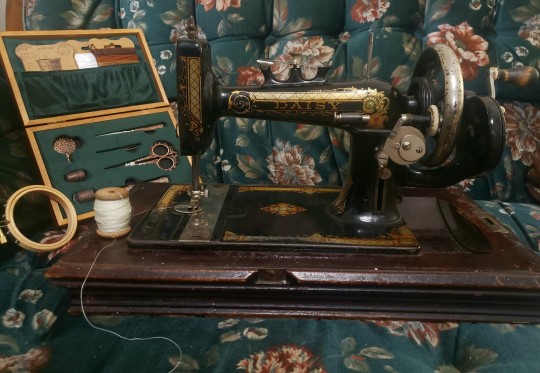
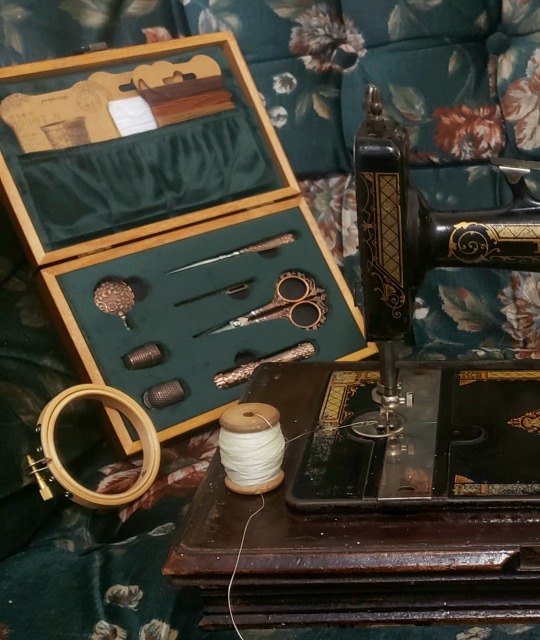
Antique sewing machine and vintage-style sewing kit.
#im super excited about this sewing kit and everything is so pretty and nice! and also the wooden box smells cozy#cottagecore#cottagecore aesthetic#crafts#crafting#artists on tumblr#cottagecore crafts#sewing#sewists of tumblr#hand embroidery#embroidery kit#embroidery scissors#sewing supplies#antique decor#antique sewing machine#vintage sewing machine#sewing machine#daisy#victorian era#edwardian era#antique#antiques#vintage#maximalist decor#needlework kit#needlework supplies
341 notes
·
View notes
Photo
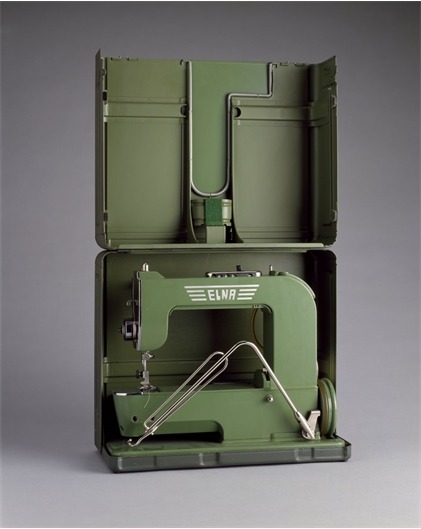
Suitcase sewing machine by ELDA, 1950, Switzerland.
238 notes
·
View notes
Text
want to make machine-washable cotton blouses
want to put trim on them that is distinctly non-machine-washable (antique black lace, velvet ribbon, etc)
woe and lamentation
#sewing#I definitely do sometimes put things with antique lace in the washing machine but I feel like black lace would be different#(on delicate; no tumble-drying. naturally.)
63 notes
·
View notes
Text
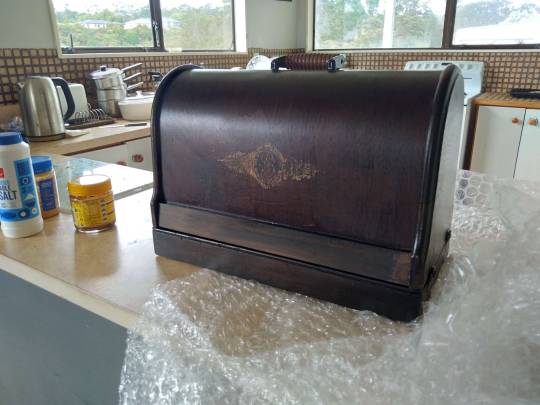



My "new" sewing machine I got myself for the holidays!
Well, I say new. She's a 116 year old hand-cranked Singer model 28, dated to the 4th of September 1907 with the grapevine designs and the "Victorian" decals if I did my research right. She pre-dates the independent governance of my country by three weeks, and can't be said to be built like a tank because she was built before tanks were invented. But whatever she's built like, she sews like a fucking champ despite being 116. Four layers of fabric on a stitch length of about a millimetre? Give her a challenge already, she takes that like it's nothing.
All she needed when she arrived was some cleaning up and a bit of tension adjustment to her presser foot!
I shall name her Bernadette, for yes I am a gullible simple bitch who got into antique sewing machines via Bernadette Banner. So in honour blame, she shall be Bernadette. And now, since I was hand-stitching before and not very well, the clothes I make shan't fall to pieces upon the mere glance of a washing machine!
#sewing#sewing machine#antique sewing machine#antique sewing#antiques#singer#singer model 28#bernadette banner
41 notes
·
View notes
Text







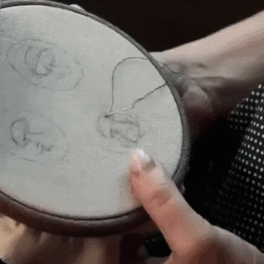

faye moreau [oc] stimboard with doll-making, sewing and taxidermy in muted tones of black, white, red and purple for @ama-kitkat123!
🧵|🧵|🧵
🧵|🧵|🧵
🧵|🧵|🧵
#talos stimboards#stimboard#stim#oc stimboard#dolls#antiques#sewing#dollmaking#sewing machine#taxidermy#animal death#bats#cats#dresses#cloth#fabric#irl hands#brown#purple#red#black#white#gray#grey#muted colors#gif ids#id in alt
49 notes
·
View notes
Text
Vintage singer sewing machine
#vintage#antique#sewing#embroidery#sewing machine#cottage moodboard#cottage vibes#cottagecore#cottage living#rustic#diy#art#sewingart#embroidered#process
91 notes
·
View notes
Text
I love that the guy in this video I'm watching talks about antique sewing machines like he's working with a delicate thoroughbred horse. "Whoa. She doesn't want to sit still for me..." Easy there, girl! That's it. Isn't she beautiful?
#Genuinely love this#🥰#Antique sewing machines are actually probably much less delicate than thoroughbred horses actually#😅#Even when they've been rusting in someone's barn for 50+ years you can usually bring them back with a little oil and a lot of love
25 notes
·
View notes
Text
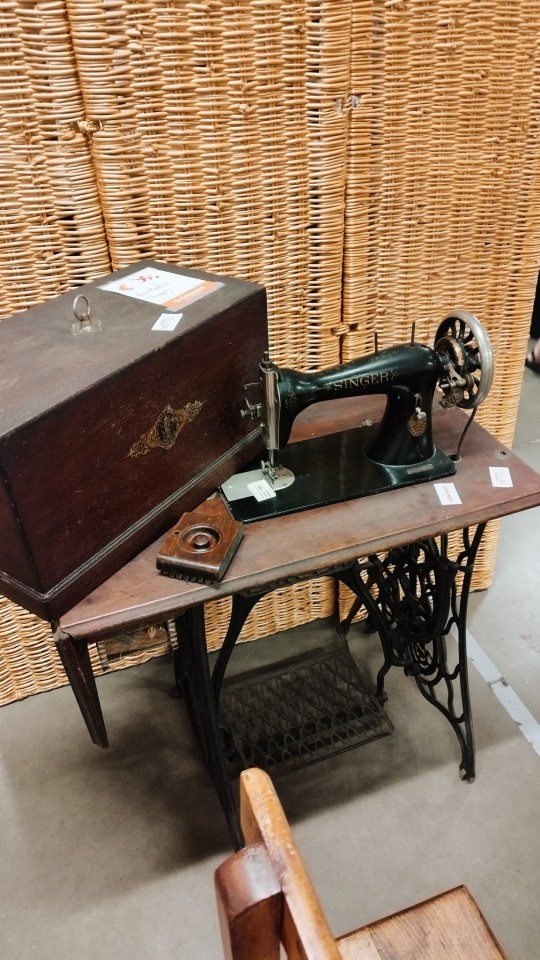
I bought this old man at the charity shop earlier. They're delivering it in about a week. If anyone has any links to useful information about antique sewing machines I'm all ears! She was built in 1857 according to the serial number and seemed functional
51 notes
·
View notes
Text
further thoughts on old sewing machines
I've read the replies and comments on the thing I reblogged about sewing machines and planned obsolescence / "they don't make 'em like they used to." You know me, I have more words to offer, and the basis here is the people saying "damn, I want one", "wow, how can I get one for reasonable?" and "you can get parts?" Read on...
First, let me show you what my friend sent me yesterday in a text. She was so jazzed that she wanted me to see it, and she doesn't even know I run a blog like this.


So here you see a White trundle sewing machine from the late 1910s to early 1920s. You can also see that it was either taken very good care of or completely restored, or both, and you have little doubt in looking at the first picture that it'll put together a prom dress or hem your cuffs at a moment's notice, and this isn't just a museum piece. In the below, I'm not just talking about the big ol' centagenarians, I mean pre-1990 Singers and everything inbetween.
You ask: Where can I find a hardy old sewing machine?
The obvious answer of antique stores aside, you can find them in thrifts. Not necessarily Goodwill because they're capitalists who have tried to get away from furniture and heavy stuff, but most of the others have them and I warn you that you may have to cut a bitch (or be cut) if one shows up at Deseret Industries. I wish I still had the photo of the time a now-departed St. Vincent de Paul near me had TWO different White models on the floor, each for less than what some people pay for Starbucks in a week, and my memory says that if they didn't spin like a top right that second a couple hours with household products and maybe a Google search plus shipping time would have these things in a functional state your great-grandmother would approve of. It's a regular thing that I go into thrifts and there's a sewing machine case on a low shelf near the electronics that is older than your mother and twice as reliable.
You ask: How much will this set me back?
Depends upon where you're shopping. Obviously antique stores will have them for more than thrifts, and sometimes you find them at estate sales (again, expect to cut a bitch) for either an antique price or a "take it away" solid price. Consider it a great day if you spend $10-$25 to get this off someone's shelf and out of someone's life.
You ask: Repairs and maintenance, what about that?
I don't know a lot about the mechanics but the older they are, the simpler they get. Resources are out there on how to fix problems (books and YouTube videos) and obtain parts, and professionals exist who live to do both. You probably know someone who has machine sewed for decades; you could ask them for insight on how to get things back into shape. People in comments on that post named some sources for replacement parts after others said they were stymied by trying to find the doodad they needed.
You didn't ask: You seem to have some passion about this despite not being a sewing machine owner or user. What machines did you grow up with?
My sainted grandmother had a 1960s Singer 401A. (Photos are NOT of her machine, I nabbed them from teh interweb.)

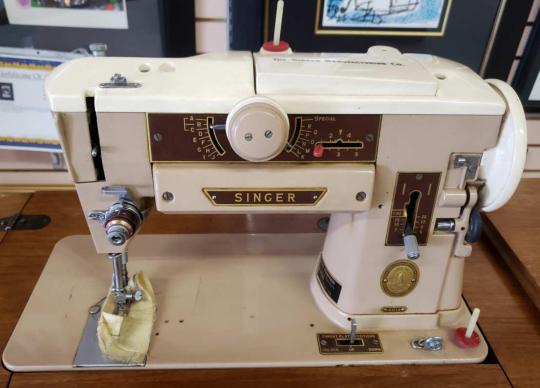
My mother still has and uses periodically her 1970s Singer 758. (Again, not my photo and I haven't seen hers out when I've visited lately.)

51 notes
·
View notes
Text

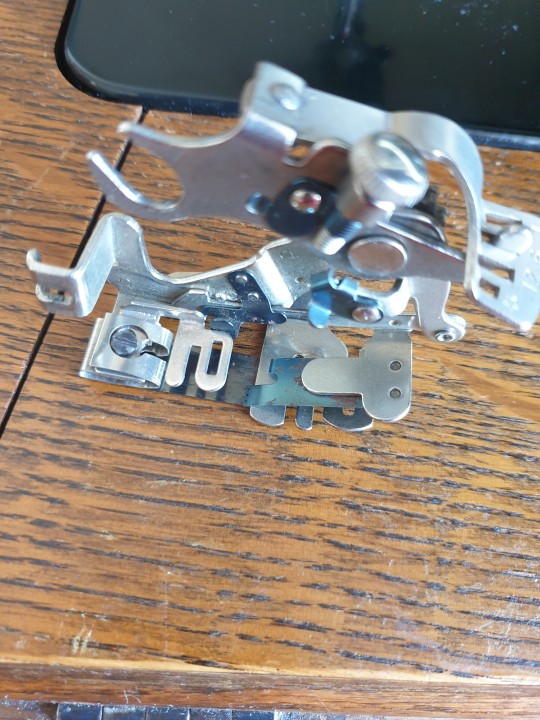
Tragedy!
Halfway through 9 meters of ruffles my ruffle attachment broke 😭
The little bit that pushed the pleat somehow got under the needle and it broke. I don't know how that is possible. Now it drops pleats🥲
#i thought it was just a broken needle#i can't even find the piece that broke off#i doubt i can find someone able to repair just that bit#but if I'm lucky i can find a new old attachment#vintage singer#antique sewing machine#treadle machine#it's a 1926 singer#the pretty one with the sphinxes#a talia original#talia's adventures in dressmaking#excerpts from my life#sewing#and i was enjoying using my old machine again so much#tragedy indeed
31 notes
·
View notes
Text

And here is my 1950s Singer sewing machine. This is also an old photo, but she was missing her bobbin, although I think she had nearly everything else. Like the others in my collection, she is a hand crank sewing machine.
#sewing machine#vintage sewing machine#sewing machines#sewing#antique sewing machine#crafts#cottagecore#cottagecore aesthetic#crafting#artists on tumblr#sewists of tumblr#antique#vintage#singer#singer sewing machine#1950s#grandmacore
103 notes
·
View notes
Text
I gotta go back to the quilt museum
#Do any girls want to be taken on a date to the quilt museum.#They have antique sewing machines also
8 notes
·
View notes
Text
Holy shit I just traded a favor with some folks to help put up a pole barn and in return I got this old peddle sewing machine!

Look at how fucking gorgeous this thing is!
12 notes
·
View notes
Photo

Credit: Mike Newbry
#sewing#sewing machine#machine#antique#vintage#rustic#london#appliance#singer#singer sewing machine#chicago#magnificent mile#USA#shop#seamstress#sew#clothing
7 notes
·
View notes
Text

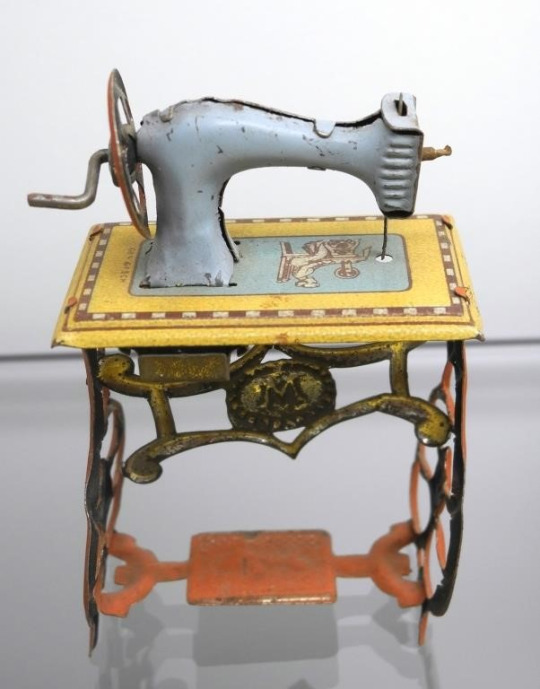
German Penny Toy Lithographed Treadle Sewing Machine Miniature
Source:
Rochester, NY
Rochester Auction House
#lithograph#german#penny toy#antique#sewing#miniature#sewing machine#treadle#mini#rochester#new york#auction#bidding#i love a good small object
21 notes
·
View notes